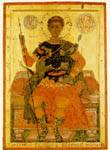|
|
| Portable Icons |
ca. mid-17th c. Iviron Monastery Wood, egg tempera, 47 x 32.8 cm |
|

|
The saint, in full battle array, is seated on a cylindrical red cushion on a backless throne, his feet resting on a footstool. Both the throne and the footstool are painted an orange-red with greyish-white brushstrokes, and the predominant red and gold of the saint's attire go well with the dark green and light blue of his cloak and breastplate. His halo is rendered with dotted ornaments. The floor imitates veined green-blue marble and the ground of the icon is gold. In two medallions, one on either side of the saint's head, are gold monograms on a red ground ornamented with gold. They form his name, 'Saint' in one and 'Demetrios' in the other; and below the medallions is the title 'The Great Duke', which is found in the iconography of St Demetrios from the fifteenth century onwards, being connected with a dream of Gregory Palamas' (Xyngopoulos 1957 (2), pp. 122ff.) The integral frame is painted gold with dotted ornaments and a red border, and the dedicatory inscription runs along the bottom: '+ΔΕΗΣΙΣ ΤΟΥ ΔΟΥΛΟΥ ΤΟΥ Θ(ΕΟ)Υ ΑΝΘΗΜΟΥ ΜΟΝΑΧ(ΟΥ)' (Supplication of the servant of God Anthimos, monk). To the same painter are ascribed three more icons belonging to Iviron Monastery: Christ the Impartial Judge; the Virgin, Lady of the Angels; and the Single Combat of Nestor and Lyaeus. All are from the Kathisma of St Demetrios and are obviously dedicated by the same monk. This St Demetrios type, which has its origins in Palaeologan works, is seen in almost identical form in an icon of the mid-sixteenth century from Mykonos (Xyngopoulos 1970, pl. IV). However, such stylistic features as the chromatic treatment of the composition, with red and gold predominating and contrasting with the limited use of dark, cold colours, the soft, painterly modelling of the figure, and the well-worked gold ground are also seen in other Athonite icons (for instance, the Koimesis of 1657 in Koutloumousiou Monastery), and place this icon of St Demetrios within the Athonite painting tradition of the mid-seventeenth century. The dotted decoration of the halo and the style of the medallions are also features of the Athonite tradition (Chatzidakis 1972 (4), p. 123).
| |
|
Bibliography: Unpublished.
| ||
| L.T. | ||
| Index of exhibits of Monastery of Iviron 17th century |
||
Reference address : https://www.elpenor.org/athos/en/e218ab88.asp